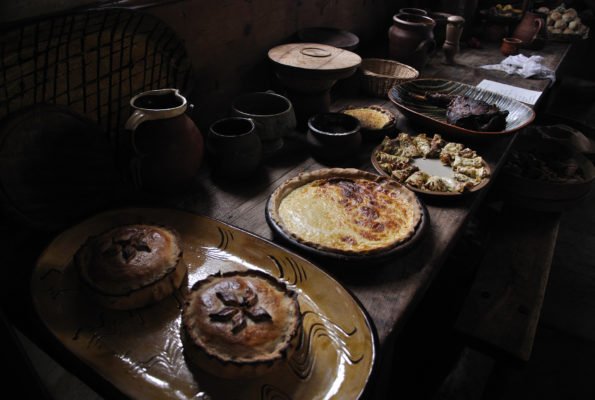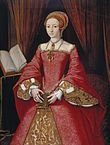Queen Elizabeth I at Table
“Queen Elizabeth was an intellectual,” Colin Spencer tells us in his book British Food: An Extraordinary Thousand Years of History, “highly civilised, and greatly disdained soporific indulgence in huge banquets and orgies of drinking. The menu for her dinner on 17 November 1576, a date that marked the eighteenth anniversary of her succession, was not a special one... A first course of choice of beef, mutton, veal, swan or goose, capon, conies, fruit, custard and fritters, manchet (the best white bread made up in small loaves), ale, and wine. The second course provided lamb or kid, herons or pheasants, cocks or godwits, chickens, pigeons, larks, tart butter and fritters.”
Although this may seem like quite a bit of food to us, historian Eric Ives tells us in The Life and Death of Anne Boleyn that at a feast held at the 1532 Field of the Cloth of Gold celebrated by Elizabeth’s father, Henry VIII, there were 170 dishes. As seen by the regularly increasing size of Henry’s armor (his waist measured 52” at the end of his reign!), these dishes were not only presented to display his wealth but were regularly indulged in. On the other hand, Elizabeth wore her small rings clear through to the end of her reign.
She cared, too, that her friends ate well for their health. Toward the end of his life, the queen teased her favorite, Robert Dudley, about his girth. In her biography, Elizabeth I, author Anne Somerset tells us that the queen “chaffed him that he should cut his daily meat consumption to ‘two ounces of flesh ... and for his drink the twentieth part of a pint of wine.’
If the Queen herself indulged immoderately in any course, it was sweets. She was known to prefer syllabubs: sweetened wine or cider blended with milk and sugar and whipped into a light, sweet foam, as well as marchpane, an almond paste candy most often known to us as marzipan. Tradition tells us that Elizabeth had terrible teeth and that, for a while, women attempted to blacken their teeth cosmetically to fit in with her royal appearance.
Elizabeth’s sparse eating habits likely contributed to her long life, but her sweet tooth may have ended her. Biographer Alison Plowden says, “The immediate physical cause of the queen’s last illness seems to have been a streptococcal throat infection, possibly connected with dental sepsis.”
Spencer says, “Elizabeth was keen to bolster the fishing industry by making sure that people consumed fish in Lent and on fast days because her fleet partly depended on the availability of the fisherman and their craft.” According to author Richard Balkwill in Food and Feasts in Tudor Times, the fish the queen ate so often would have been kept fresh by being wrapped in cool seaweed and stored in a wet larder at Hampton Court Palace.
By the end of the Tudor era, food choices for all were not so much predicated by religious calendars and royal decree as by the wealth of the individual. Author Spencer writes, “It was now becoming possible for individuals to rise in the world, and if you had money, you flaunted it.” Sumptuary laws were flouted, and “nothing could stop the gentry from flaunting their riches in food and clothing.” Which meant, of course, black teeth earned properly for the well-to-do of any rank.
{ Main photo credit: Used with purchase permission from iStock }
{ Queen Elizabeth I photo: By Formerly attributed to William Scrots, Public Domain, https://commons.wikimedia.org/w/index.php?curid=686176 }
{ Marzipan photo credit: Used with purchase permission from iStock }



